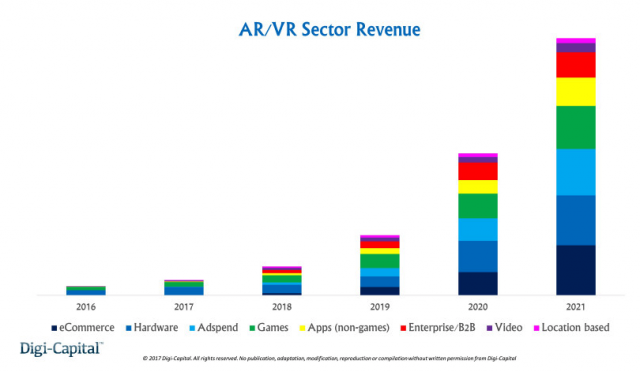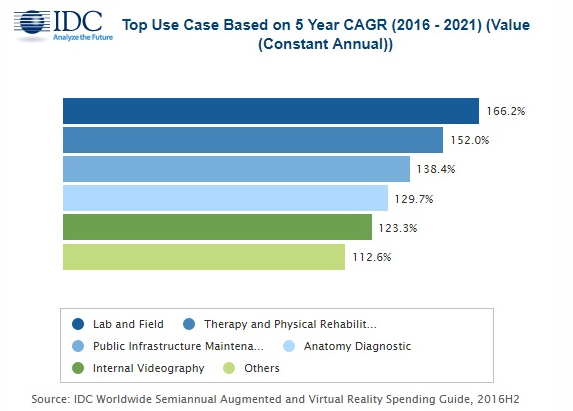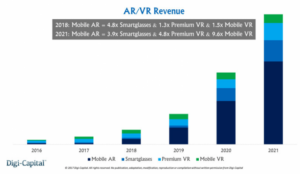In case you missed it, at the most recent Facebook virtual reality developer event last week, the top social network founder, Mark Zuckerberg, announced in his keynote the aggressive goal of 1 billion VR users. He revealed a roadmap that is intended to displace desktop monitors to help move AR/VR technology, which is currently stuck in the slow lane of adoption.

The company announced a non-tethered “Oculus-Go” device that will sell at sub-$200 creating the “most accessible VR experience ever”, according to Zuckerberg, who also said the low cost device will ship in 2018. But new marketing data suggests it’s mobile augmented reality (AR) not VR that will dominate, with 900 million users as early as 2018, and in the longer term having even more significant numbers at up to 25X virtual reality adoption.
According to Tim Merel of analyst/consulting firm, Digi-Capital and detailed in its most recent AR and VR market update report, mobile AR (not using headsets) is set to have more than double the number of users at launch in 2017 than the entire AR/VR headset market forecast by 2021. The simple reality is the three top AR initiatives (Apple ARKit, Google ARCore, and Facebook’s Camera Effects Platform) are expected to have a whopping 900 million users by the end of 2018 according to the group. According to Merel, in the Augmented Reality Report and Virtual Reality Report.the net effect is
“…their launch is changing the trajectory of the whole market. DigiCapital has fundamentally revised the AR/VR market thesis, analysis and forecasts,”
They are not alone, In IDC’s August report, quoted by Business Insider, total spending on AR/VR is expected to soar from $11.4 billion in 2017 to nearly $215 billion 2021, at a CAGR of 113.2%. IDC said the combined worldwide revenues for the augmented reality and virtual reality (AR/VR) market are forecast to increase by 100% or more over each of the next four years, according to its latest update – Worldwide Semiannual Augmented and Virtual Reality Spending Guide.
Augmented vs. Virtual Reality Revenue, Source Digi-capital AR VR 2017Calling it the “800 pound gorilla”, Merel said “Mobile AR’s installed base could grow to over 3 billion by 2021, while smartglasses, premium VR and mobile VR combined might top 100 million in the same timeframe (so tens of millions for each platform individually). This makes mobile AR’s installed base more than 25 times all AR/VR headsets long-term”, he said in his @DigiCapitalist Venturebeat blog October 2, 2017.
 The top five conclusions of the recent updated report include:
The top five conclusions of the recent updated report include:
- Mobile AR dominates AR/VR for the foreseeable future;
- Smartglasses remain the long-term future of AR/VR, but could take into the next decade to become a mass-consumer market;
- VR’s market potential has been diminished by the emergence of mobile AR as a rival platform;
- Premium VR might not accelerate until second-generation standalone (neither PC nor mobile tethered) VR headsets emerge in 2019/2020; and
- Mobile VR’s potential has been reduced due to phone makers and developers pivoting towards mobile AR.

Meanwhile, Zuckerberg’s idea is to create a standalone VR hardware device with complete freedom of movement, something that has eluded the company to date. If the recent dev-con is any indication, Zukerberg and team see “usability” and “connection” as keys to the success of the technology. Never mind the Samsung Gear VR currently sells today for $129 (but assumes you already have the smartphone that provides the onboard display and processing.)
Another way the company is working to get to that 1 billion user number, is to optimize PC app windows for VR with a new software interface called “Dash.” According to Oculus conference speaker, Nate Mitchell Oculus co-founder and head of Rift, Dash will offer “…best in class performance and visual quality,” for PC apps in virtual reality, creating “…a path to replacing real monitors entirely.”
Ummm, that’s some Kool-Aid they are drinking over there… (Here Mark, put these on while you update your e-mail FB page and work on the latest blog…) really?
Mitchell announced the ‘Core 2.0’ software update, coming to the Rift (beta) in December 2017 that will overhaul the existing OS with a focus on motion input. It condenses the functionality of “Home” and the “Universal Menu” he said.
Facebook also revealed an in house VR project “Venues” that described how the social network behemoth is working to conduct live-interactive events using personal avatars in an animoji-like way that tracks facial and eye movements in a secure environment.
But even if the combined software/hardware improvements meet the personal, social and customizable goals of the group,the inconvenient reality for Mark Zukenberg and his $2B investment in the Oculus VR hardware is far different. In spite of it’s massive investment of $2B in Oculus Rift back in 2014, the smart money seems to be betting on mobile AR technology that augments our world with useful, memory prods, glanceable updates, data points and even (yes) driving directions all superimposed on our lovely 3D time space reality. – Stephen Sechrist
Logistics Leading the way in Augmented Reality Usage and Adoption
IHS Markit Publishes Virtual Reality in Retail Blog
Vive X Debuts 33 Virtual Reality Startups During Demo Days in Taipei, San Francisco And Shanghai
Facebook / Oculus Files Patent for AR Headset
Apple Tours the World in Support of AR
Facebook Rumoured to be Developing Mid-Range Mobile VR Headset
Snapchat, Facebook Fuel AR Growth
Research is Showing that Augmented Reality Games Can Be a Good Thing

